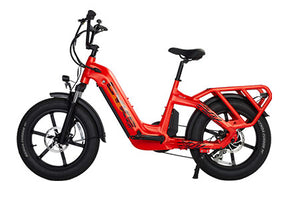Featured in this posts
Torque Sensor vs Speed Sensor on eBikes: How to Choose?
When selecting an eBike, one of the most important decisions to make is choosing the right type of pedal-assist sensor. There are two primary sensor types: the torque sensor and the speed sensor. Both affect your riding experience in different ways, from how the motor delivers power to how your eBike feels on the road.
Choosing the right type of sensor for your eBike is crucial for optimizing your riding experience. In this article, we discuss the following topics to help you understand the differences between torque sensors and speed sensors, their advantages and disadvantages, and how they impact your overall ride.
What Is a Torque Sensor on an eBike?
A torque sensor measures the force applied by the rider when pedaling. It adjusts the motor's assistance based on the rider's effort, providing a more natural and responsive riding experience. The more power you exert on the pedals, the more assistance the motor delivers, making it ideal for hilly terrains or challenging routes.
Advantages of a Torque Sensor
- Enhanced Control: Torque sensors provide precise control over the amount of motor assistance, making it easier to navigate varying terrain.
- Natural Riding Feel: Riders enjoy a more intuitive and bike-like experience since the motor responds directly to pedaling effort.
- Efficiency: By adjusting power based on rider input, torque sensors can help conserve battery life during long rides.
Best eBikes with Torque Sensors
The Cross Series Softail & Full-Suspension eMTB is equipped with a Torque Sensor and a Thumb Throttle for a more natural cycling feel and instant power control. With their high-end components, affordable torque sensor ebikes
Falcon A Mid-Drive eMTB with Torque Sensor
√ Torque Sensor
√ RockShox Four-bar Suspension
√ 28mph Top Speed
√ 67-Mile Range
√ Lifetime Warranty for the Frame
Price: $2,999
Falcon S Mid-Drive eMTB with Torque Sensor
√ Torque Sensor
√ RockShox Four-bar Suspension
√ BAFANG 1000W Mid-Drive Motor
√ 28mph Top Speed
√ 58.9-Mile Range
√ Lifetime Warranty for the Frame
Price: $3,199
Falcon X Mid-Drive eMTB with Torque Sensor
√ Torque Sensor
√ RockShox Four-bar Suspension
√ BAFANG 1000W Mid-Drive Motor
√ 28mph Top Speed
√ 53-Mile Range
√ Lifetime Warranty for the Frame
Price: $3,199
Disadvantages of a Torque Sensor
- Cost: eBikes with torque sensors are generally more expensive than those with speed sensors.
- Complexity: The technology can be more complex, which may lead to higher maintenance needs.
What Is a Speed Sensor on an eBike?
A speed sensor, on the other hand, measures the rotational speed of the bike’s wheels. It calculates the speed of the bike and sends this information to the motor controller. This allows for a consistent level of motor assistance based on the bike's speed, rather than the rider's effort.
Advantages of a Speed Sensor
- Affordability: eBikes with speed sensors are usually more budget-friendly, making them an excellent choice for entry-level riders.
- Simplicity: Speed sensors are often easier to maintain and repair compared to torque sensors.
- Consistent Assistance: The motor provides a stable level of power as you reach different speeds, making it great for casual riding.
Best eBikes with Speed Sensors
The Family Series electric bikes use the Speed Sensor. The Family Series electric bikes include commuter, hunting, cargo, and foldable e-bikes, each designed to ensure everyone in the family finds their perfect fit.
Cheetah Hunting eBike with Speed Sensor
√ Speed Sensor
√ Up to 450 Pounds
√ 28mph Top Speed
√ 80-Mile Range
√ Lifetime Warranty for the Frame
Price: $1,899
Lynx Step-Thru eBike with Speed Sensor
√ Speed Sensor
√ Up to 450 Pounds
√ 28mph Top Speed
√ 80-Mile Range
√ Lifetime Warranty for the Frame
Price: $1,899
Collie Cargo eBike with Speed Sensor
√ Speed Sensor
√ Up to 450 Pounds
√ 28mph Top Speed
√ 80-Mile Range
√ Lifetime Warranty for the Frame
Price: $1,699
Grizzly Folding eBike with Speed Sensor
√ Speed Sensor
√ Up to 450 Pounds
√ 28mph Top Speed
√ 80-Mile Range
√ Lifetime Warranty for the Frame
Price: $1,699
Disadvantages of a Speed Sensor
- Less Responsive: Speed sensors may not adjust the motor's output based on how hard you're pedaling, leading to a less connected feel when riding.
- Higher Battery Drain: Since the motor does not scale its output according to rider effort, it can lead to quicker battery depletion, especially if you're using maximum assistance.
How to Choose Between Torque Sensor and Speed Sensor?
When deciding between a torque sensor and a speed sensor, consider the following factors:
- Riding Style: If you enjoy a more dynamic and responsive ride, a torque sensor may be the best fit. For casual riders or those seeking a straightforward experience, a speed sensor could suffice.
- Terrain: Riders frequently tackling hills or varied terrain will likely benefit from the enhanced control offered by a torque sensor.
- Budget: If affordability is a priority, speed sensor eBikes tend to be less expensive, providing good value without compromising essential features.
Conclusion
In summary, both torque and speed sensors have their unique benefits and drawbacks. Your choice ultimately depends on your riding style, the type of terrain you plan to tackle, and your budget. Whether you opt for the precision of a torque sensor or the simplicity of a speed sensor, CYKE Bikes has a range of options to enhance your eBike experience.

















